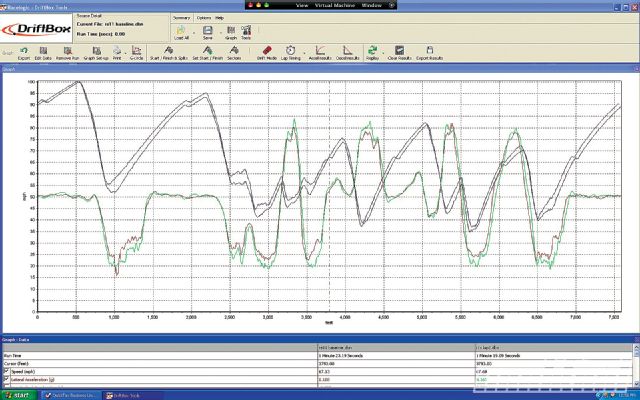 | BFGoodrich g-Force R1-S - Tire Review
| BFGoodrich g-Force R1-S - Tire Review
Specs & Details
BFGoodrich g-Force R1-S
Type DOT track and competition tire
Sizes from 205/50ZR15 to 335/30ZR18
UTQG 40 B A
Key Features
- Uses an enhanced competition tread compound molded into a symmetric, nondirectional, semislick tread design with 1⁄8 inch of tread depth
- S compound offers more ultimate dry grip, comes up to temperature quicker and provides more grip in cooler ambient temperatures on tracks that are easier on tires (compared with the standard g-Force R1)
- Wears quicker than the standard g-Force R1 tire and is not as well suited to extremely hot days
- Should not be mixed with the standard R1
Test Mule
Project RX-8
Test Driver
David Pratte, Columnist and Contributor
Test Track
Toronto Motorsports Park, Kohler, Ontario, Canada
Track Conditions
82 degrees F, sunny and dry
It’s no secret I’m a huge fan of the standard BFGoodrich g-Force R1, having spent many hours racing on them in a wide range of conditions during three different 25 Hours of Thunderhill endurance races. I even wrote a glowing review of the R1 for this illustrious magazine, extolling its virtues as an endurance racing tire, but noted that it wasn’t really suited to time attack or autocross racing because the compound takes quite a while to heat up.
I guess someone at BFG was listening, because the new R1-S (where the S stands for Sprint but could just as easily mean Soft compound) is designed specifically with sprint racing, time attack, and autocross use in mind. As Karl Koenigstein, BFG Motorsports technical team leader, explained, the standard R1 and R1-S use the same construction, the only difference being the softer compound used on the S tire.
During testing on Project RX-8, I was immediately impressed by the slick-like grip levels. I didn’t have to so much as touch the dampers or chase performance with obsessive monitoring of tire temp and pressures; these things just gripped like gangbusters from the first corner.
As our Driftbox data acquisition system showed, the RX-8 was now four seconds a lap faster than it had ever been before. As you can see from the data overlay of the R1-S (blue speed line, green lateral g line) versus the Bridgestone RE-11 street tires (black speed line, red lateral g line), the RX-8 was faster everywhere and pulling some huge cornering g’s on these super sticky BFGs.
One of the characteristics of the standard R1 I found a bit tricky was how peaky it is, meaning once you go past the peak of its grip curve, you lose traction quite quickly. The R1-S tires, however, break away much more gradually, making them friendlier to drive at (and a bit beyond) their limit.
According to Karl at BFG, this assessment coincides with feedback they’ve been getting from other drivers, who’ve also reported that the R1-S has a broader grip peak than the standard R1.
What I can’t say is how long the R1-S will last or how many heat cycles it can take before lap times start to drop off, since I only got a couple of five-lap sessions in on them before the sun set. But there was no sign of the compound overheating after five laps—in fact, my fastest lap was my last lap, most likely because I was starting to drive closer to the tire’s incredibly high grip limit. That said, Karl did share that on heavy cars and abrasive surfaces (and heavy-handed drivers), the R1-S might be a one-race tire, at least on some corners of the car. But on car/driver combos that are easier on tires, they can certainly last multiple sessions or race days before the tire’s performance starts to drop off.
Based on this initial test, it would certainly appear that the BFGoodrich g-Force R1-S is a very serious competitor of other soft-compound DOT race tires such as Hoosier A6s and Hankook Z214 C70/90s.
 | MODP-130100-TIRE-090-
| MODP-130100-TIRE-090-
